This is a busy time for birders, and an exciting period to enjoy photographing birds as this nesting season continues and new hatchlings and fledglings emerge. It’s important to stay aware of the potential of seeing young birds, and spending some extra time in their company when possible with the hope of getting some seasonal photographs. At the same time, as always we need to make sure we do not affect young birds or their attentive adults during their critical periods of development.
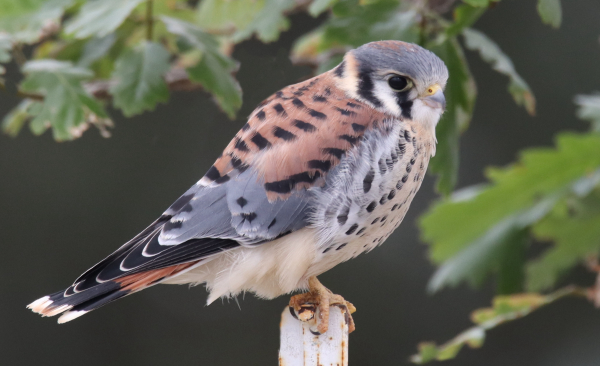
Cloudy conditions after sprinkling rain at the time the American Kestrel fledglings were found made photography questionable in the low light, but by using an ISO of 800 and an aperture of f-6, some good initial images were possible (600mm zoom lens, f-6 aperture, 1/800 shutter speed, 800 ISO).
In some cases, you may even find a family group of fledglings, still protected and “schooled” by one or both adults. A few species have extended post-fledging periods that can be especially interesting to study – and to photograph if conditions are right. This is most notable among birds of prey, in which the adult pair cares for fledglings during a number of weeks, protecting and feeding them during the “post-fledging period” when the quickly developing fledglings learn to fly and learn to catch appropriate prey. This in addition to learning what things might represent hazards – other animals, people, moving vehicles, and more.
While it’s important not to impact or displace fledglings during their critical fledging period, after assessing potential impacts to fledglings from a distance, you may find a way to observe and even photograph from a distance. Recently, I had a surprise opportunity to observe a family group of American Kestrels, revealed when I noticed a kestrel perched on the ground near a rarely used street adjacent to the edge of a new housing development in southwest Fargo, a location where I’ve been photographing Gray Partridges periodically during the past 9 months.
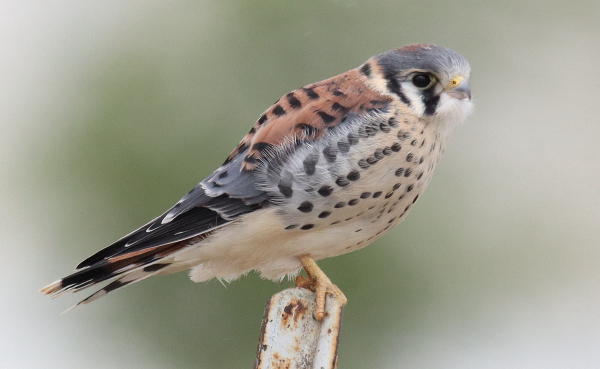
A dreamy quality to the background was actually created by positioning the mobile blind where a distant out of focus white fence brightened the background, with some equally out of focus oak leaves adding a green accent. Note the short tail feathers on the kestrels in this and the previous photo, an initial indicator that these kestrels only recently left the nesting cavity (600mm zoom lens, f-6 aperture, 1/1250 shutter speed, 800 ISO).
When I saw the kestrel perched on a 2 foot high mound of dirt, I couldn’t stop quick enough, and the kestrel flew a couple hundred feet to another 3 foot high mound of dirt, where 2 other kestrels were already perched. Hmm, obviously these were new fledglings, still bound together by sibling ties created within the confines of their nest cavity. These young birds might provide an interesting photo opportunity, so I parked my car on the side of the street where I could watch any interactions or movements.
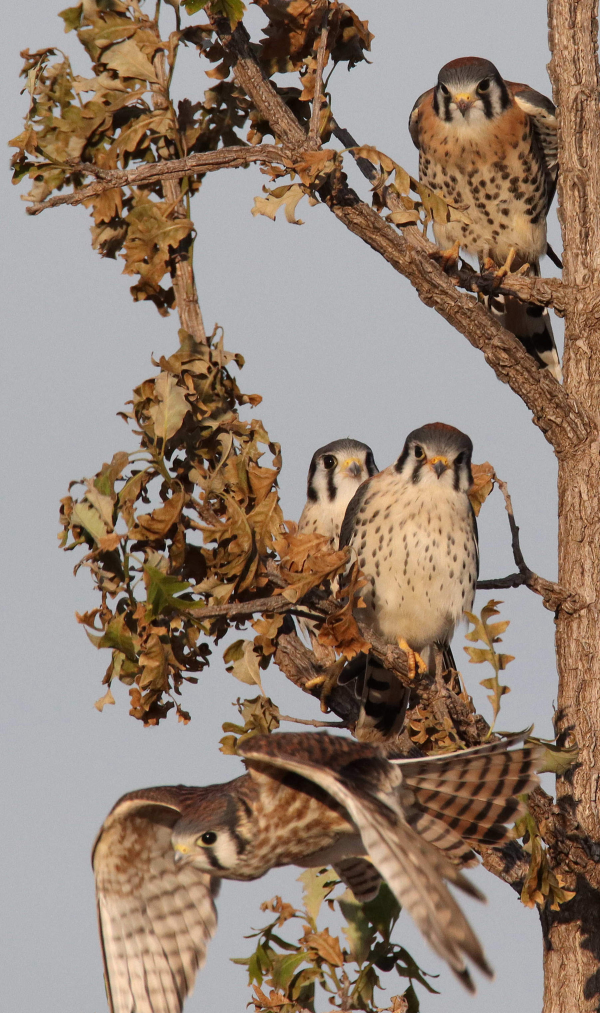
Taken a week after the first 2 images, this and the following photographs were taken in full sunlight during early evening. The opportunity to photograph more than 1 fledgling in a single photo frame was especially lucky, to say nothing of photographing all 4 fledglings together (600mm zoom lens, f-8 aperture, 1/2000 shutter speed, 800 ISO).
|
Soon an adult female American Kestrel flew in and began hovering – on the hunt – between me and the fledglings. She left, but one fledgling flew after her, which prompted the other 2 to take to the air, although they were more interested in chasing one another, making fast falcon-like turns and twists and dives relatively low above a small shallow wetland. Their next stop was across the street to newly planted trees in a brand new elementary school parking lot – now deserted before school begins in September.
The young kestrels perched low in the young oak trees and on adjacent metal posts that were installed to anchor the newly planted oaks. I repositioned my mobile blind (car) and saw that the fledglings did most of their own hunting on the ground, on the sidewalk, or on the recently paved parking lot – chasing bugs on foot, or flying from a perch to finish the chase on the ground. There were 3 fledglings – 2 males and 1 female – and when 1 mini-falcon seemed to be on the right track to catch a bug, another would join the action in an act of competition, or hunger. Their focused attention allowed me to slowly, quietly move into position time and time again to photograph, which was mildly successful from a safe distance that didn’t attract their attention.
With low clouds and sprinkles the norm for that day, I didn’t expect very good photo colors without sunshine, but I was surprised to see the images I checked on my camera’s rear-side LCD screen showed pretty good promise, so I kept photographing, using a narrow aperture (f-6), which provided an ample shutter speed at ISO 800. It was great fun to see the fledglings interact, on the ground and in the air, but after about 45 minutes, during which I kept my distance and didn’t concern the young kestrels in the least I felt I should leave the kestrels knowing I may have some satisfactory photos. At the same time, I hoped the fledglings would remain in this post-fledging territory, which provided a mix of open habitat to the south of the unused parking lot that seemed to be equally attractive to the kestrels – fledglings and adults.
Remix Six
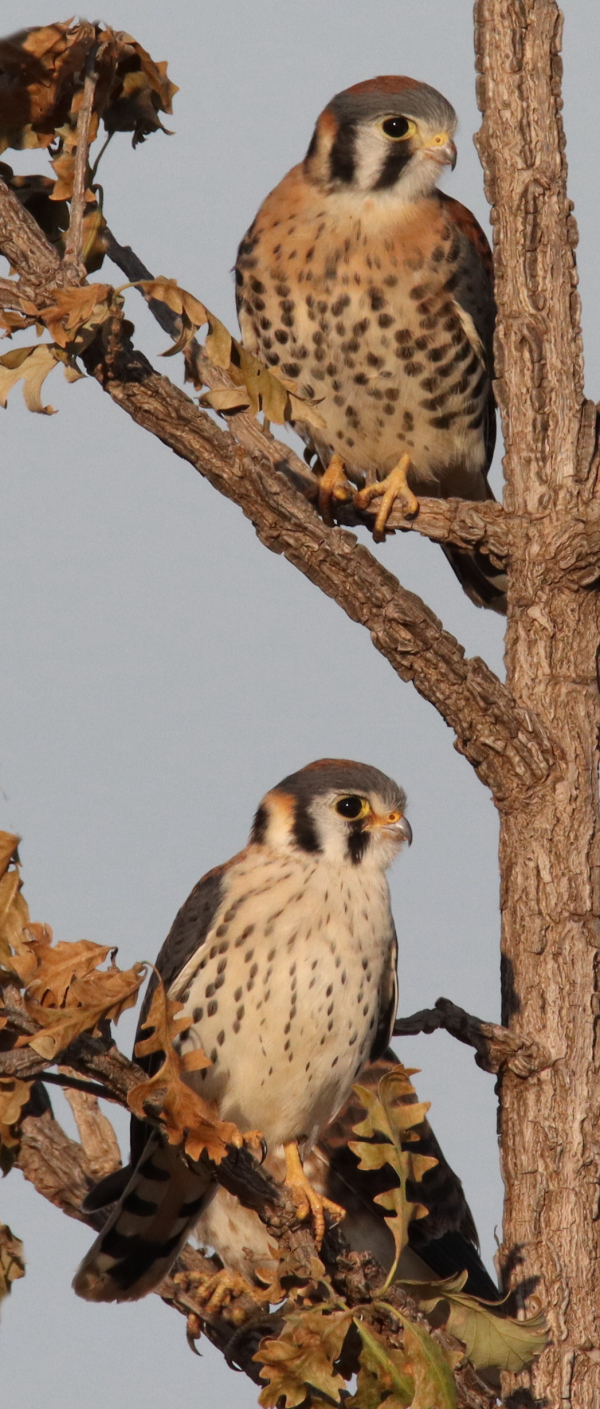
Both of these kestrel fledglings are males, showing the color variation of kestrels’ breast plumage, even within the same brood. Among the 3 males, 2 had white undersides with black spotting, but the male perched at the top of this image had a rufous-orange ventral color with dark spots (600mm telephoto lens, f-8 aperture, 1/2000 shutter speed, 800 ISO).
|
Six days later, last Wednesday, I decided to check back on the fledglings to see if they were still in the area with the hope of photographing them under sunny conditions. I arrived about 5pm with ample sunlight at my back, and after a short wait in the empty parking lot, the first kestrel appeared, followed by another, and the chase was on in playful falconesque flight. Over the next half-hour I caught fleeting glimpses of the kestrels, glad to see they were still around, but a little frustrated they were not more photo accommodating. Hunger got the best of me after about a half-hour, and I figured a short break away from the area wouldn’t hurt at that point.
I returned about 6:30 to find 3 fledglings active in the area, but in a much larger area than before, ranging a quarter mile farther south, more than a quarter mile east, and a few hundred feet north. I followed them to 2 locations where I managed a few so-so photos of the female perched on decorative street lights and a billboard, but it seemed I was forcing the issue over that 35 minute period. Maybe if I backed away a bit to watch the kestrels, it might pay off as the light was nearing peak evening illumination.
Back at the school parking lot, I parked in view of a young male that actually flew closer to me, just 8 feet away. While I took a couple full-frame photos the angle of the sunlight wasn’t right with the kestrel perched to my side rather than in front of me. And that’s when he almost landed on my car, landing just a foot or so away to grab a bug from the pavement near a front tire. As it took flight again, the little falcon flew low across the lot to land in one of the small oak trees – an oak where 2 other kestrels were already perched!
What were the chances I could get into position with open views of the kestrels among the oak leaves without alarming one or all of them? As it turned out, pretty good; in fact, a fourth fledgling arrived just after I began photographing – WoW! It was exceptional to have them positioned on natural perches in the little oak with clear blue sky showing through from behind and the prettiest light anyone could hope for illuminating them from behind me – what luck! And the opportunity continued for an extended period during which fledglings arrived and left and repositioned in the tree, all to the delight of this photographer.
As it turned out, there were now 3 males in the family group with the lone female fledgling. The first 2 males had white breasts with black spots, but the new male had rufous-colored breast plumage with dark spots. Perhaps this was the last kestrel in the brood to fledge, leaving the nesting cavity after my first photo session with the brood. To underline that possibility, the rufous-breasted male was not as active as the other fledglings, but it added a lot to the resulting photos of 2, 3, or 4 fledglings together – how koool.
Again, it paid off to be patient, spend some extra time with the birds, observe from a distance, make the most of what could potentially transpire, and at the ‘peak’ of the evening light, it all came together in a beautiful fashion – hooray! Only during the post-fledging period would you have the chance to photograph 3 and 4 fledglings in the same photo frame, so keep your eye’s peeled for fledglings you may encounter, ranging from Mourning Doves to Bald Eagles, they are learning to fly and feed themselves now, while learning the ropes of how to survive in this big ole’ world, so it’s important not to disturb them – the birds come first, especially at this stage.
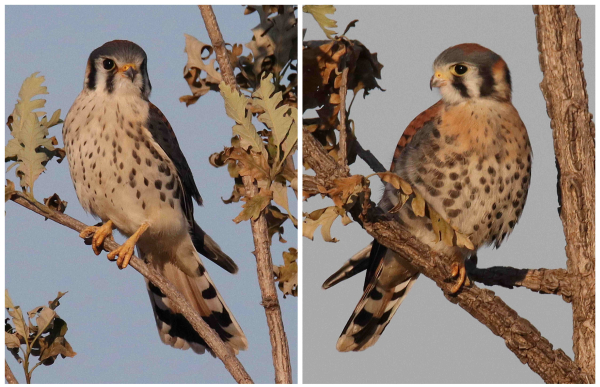
The chance to take a variety of photos of the brood of American Kestrels was a thrill, especially under prime lighting conditions during the second photo session. These portraits were the result of the birds choosing natural perches with an open sky background, and our photographer positioning to make the most of each opportunity to focus on individual birds (600mm zoom lens, f-8 aperture, 1/3200 and 1/2000 shutter speed, 800 ISO.)
Another thing about new fledglings on the scene is that there will soon be twice or 3 times as many individuals of many species as the season of reproduction re-populates with a new generation – how exciting. Although not in the case of the kestrels, in some cases, recent fledglings have a different plumage than adults, which may last for a few months, or even a year or more. With more birds on hand, the post-fledging season and beyond is truly a boon to birders, especially birders with cameras in hand – Enjoy the season!
Article and Photographs by Paul Konrad
Share your bird photos and birding experiences at editorstbw2@gmail.com